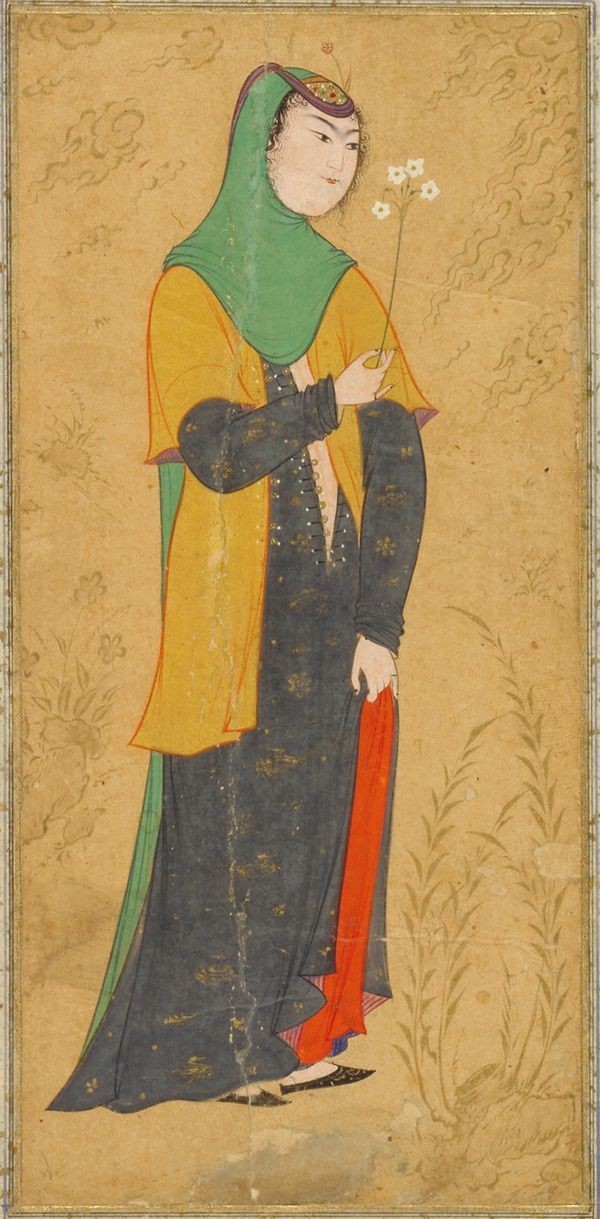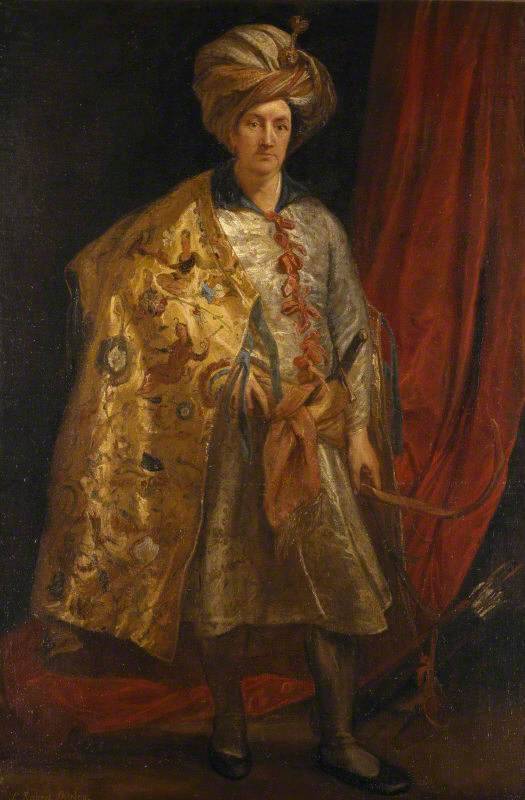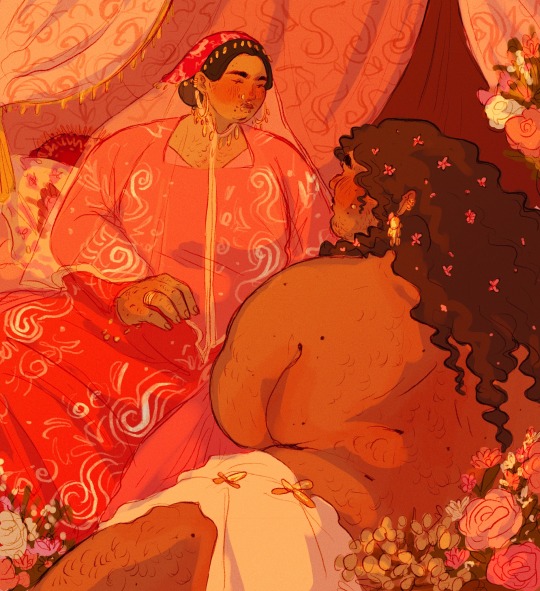#persian clothing
Explore tagged Tumblr posts
Text

Woman with a spray of flower, 1595, perisan art, Ispahan
#persian#persian art#farsi#islamic#islamic art#floral#iran#iranian#flower#illumination#Illustration#book illustration#art#colour#colourful art#16th century#oriental#oriental art#persian empire#modesty#persian clothing#historical#traditional#Isfahan#ispahan
32 notes
·
View notes
Text
the sumeru crowd of my drawing a genshin character a day so far




i did a lot of research for candace for what hair types and styles would have been common when the term kandake was used the most also the outfit based off basically one of the earliest examples of a clothing kadakes would have worn (thank u wikipedia sources)
nilou is wearing a pretty typical Persian dancing dress, nahida has four arms and kaveh has his boobs out
#genshin impact#sumeru#traditional art#genshin candace#genshin nilou#genshin nahida#genshin kaveh#kandake#persian clothing#artists on tumblr#moobs#my art
4 notes
·
View notes
Text

Persian Miku!?
In traditional Mazani clothing from persia!
More info⬇️⬇️
Mazandaran province is one of the 31 provinces of Iran. Its capital is the city of Sari . Located along the southern coast of the Caspian Sea and in the adjacent Central Alborz mountain range.Mazandaran is a major producer of farmed fish, and aquaculture provides an important economic addition to traditional dominance of agriculture. Another important contributor to the economy is the tourism industry, as people from all of Iran enjoy visiting the area.
Language: The population is overwhelmingly Mazandarani, with a minority of Gilaks, Azerbaijanis, Kurds, Georgians, Armenians, Circassians, Turkmen and others, Mazandarani people have a background in Tabari ethnicity and speak Mazandarni.
Culture( literature) : In the Persian epic, Shahnameh, Mazandaran is mentioned in two different sections. The first mention is implicit, when Fereydun sets its capital in a city called Tamishe near Amol:
بیاراست گیتی بسان بهشت.................... به جای گیا سرو گلبن بکشت
از آمل گذر سوی تمیشه کرد .............. نشست اندر آن نامور بیشه کرد
And when Manuchehr is returning to Fereydun's capital, Tamisheh in Mazandaran (known as Tabarestan), after his victory over Salm and Tur.
Arash the Archer is a heroic archer-figure of Iranian mythology. According to Iranian folklore, the boundary between Iran and Turan was set by an arrow launched by Arash, after he put his own life in the arrow's launch. The arrow was traveling for days before finally landing on the other side of the Oxus on the bark of a walnut tree hundreds of miles away from the original launch site atop a mountain
Music and dance:
Music in this region relates to the lifestyle of the inhabitants, and the melodies revolve around issues such as the forests, cultivation or farming activities and herding. The most famous dance of this area is the Shomali dance, not forgetting the stick dance that the men perform. Popular music in the province, known as the Taleb and Zohre, Amiri Khani and Katuli.
Cuisine :
The cuisine of the province is very rich in seafood due to its location by the Caspian Sea, and rice is present in virtually every meal. Mazandarani cuisine is diverse between regions; the cuisine of coastal regions is different from mountainous regions, as people in the Alborz usually use the indigenous herbs and coastal people use the dishes of fish and Caspian Mazandaran rice with vegetables.
#art#design#anime#fashion#fanart#miku#hatsune miku#vocaloid miku#miku fanart#persian#ancient persia#mazani clothing#twitter#artists on tumblr#my art#illustration#vocaloid#traditional clothing#traditional costume#miku challenge#international miku
2K notes
·
View notes
Text


Contributing to the "Draw Hatsune Miku based on your culture" trend with a Persian Court Dancer Miku eheheeee
#evil bitch creations#hatsune miku#miku hatsune#iran#vocaloid#so there were MANY traditional clothes/costumes I was considering from Iran for miss Miku!#but Persian Court Dancer attire stuck to me
710 notes
·
View notes
Text









“I saw myself sitting in the crotch of this fig tree, starving to death, just because I couldn't make up my mind which of the figs I would choose. I wanted each and every one of them, but choosing one meant losing all the rest, “
- Sylvia Plath, The Bell Jar
#dark academia#academia#light academia#poc dark academia#blackademia#black academia#dark academia clothing#dark acadamia aesthetic#poc light academia#red aesthetic#red carpet#fresh figs#pomagranate#persian rugs#all about love#coffee aesthetic#cottage aesthetic#coffeeblr#black love#soft black women#soft black girls#dark academia moodboard#moodboard#sculpture#wine#fall vibes#fall season#autumn#apple pie#apple picking
161 notes
·
View notes
Text

Persian women, Iran, by Michele Moroni
#persian#iran#asia#west asia#folk clothing#traditional clothing#traditional fashion#cultural clothing
660 notes
·
View notes
Text
Feeling so POWERFUL AND STRONG after a GREAT PUMP!
#renad efendiyev#azerbaijani muscle#azerbaijani beef#Persian muscle#Arab muscle#Persian beef#arab beef#muscle worship#muscle god#muscle beast#roided muscle#roided monster#cocky muscle#roided beast#roided power#muscle flex#muscle power#gym muscle#clothed muscle#bodybuilder
50 notes
·
View notes
Text

Sir Robert Shirley (1581-1628)
Artist: Sir Anthony Van Dyck (Flemish, 1599-London)
Date: 1622
Medium: Oil on canvas
Collection: National Trust Collections, United Kingdom
Description
This fascinating portrait, dressed in Persian clothes, was painted in Rome in 1622. Robert Shirley was an adventurer, who from 1608 served as ambassador to the Persian shah Abbas the Great (1571–1629) and adopted Persian customs. Teresia Shirley was Circassian (people from the north-east shore of the Black Sea in Russia) and is shown seated demurely against a view of Rome. The painter, Sir Anthony van Dyck (1599–1641), may have been attracted to painting these sitters partly as a result of the stunning visual effect of their lavish clothes.
#portrait#full length#oil on canvas#sir robert shirley#persian clothes#flemish art#view of rome#man#oriental costume#turban#english traveler and adventurer#fine art#oil painting#artwork#sir anthony van dyck#flemish painter#european art#17th century painting#national trust collections
21 notes
·
View notes
Note
I know this can be too much of an outlier, but do we have any idea if Alexander was a particularly fashionable person? Either if he was into fashion itself or if he was considered fashionable in his clothing style for example
Clothes Make the King?
Alexander’s clothing choices weren’t about fashion, but about POLITICS. What he wore sent a message.
First, three quick points about clothes in ancient Greece:
They were relatively simple with few sewn seams, and by Alexander’s day, any patterning largely along the edges. Most was made of wool, linen being very pricy.
They were made at home by one’s female family members. Yes, even the wealthy. A woman’s worth wasn’t measured by her pie crust or biscuits, but her weaving quality.*
They were expensive if one had to purchase cloth (as opposed to having it made at home). Most people had only a handful of tunics, one cloak and/or one himation (wrap), and one pair of shoes.
And finally, pertinent to this discussion:
By the 4th century, especially austere clothing was associated with moral virtue, while highly patterned clothing + lots of jewelry with moral decadence (the East/Persia).
Ergo, descriptions of Alexander’s clothing in the sources send a moral message: as he descended into vices and Asian tyranny, authors show him wearing extravagant, Asian-style clothing.
BUT he also did make choices of what to wear (insofar as we can be sure they were his choices), that conveyed his own messaging. Detangling his messaging from later author’s messaging is a continual problem, but sometimes it’s possible.
We’re told Alexander dressed the same as his soldiers. Differences in wealth would have been indicated by the quality of the wool and COLOR, but not the style. Being able to wear, say, black (made from the wool of baby lambs born black but who turn white as they age), or saffron yellow (made from the tiny pistils of flowers), or dark blue or purple (made from murex snails and imported at a hefty price)—THOSE tell you the person has money. The cut and drape of the clothing mostly doesn’t. You can pick out the king by the bright dot of yellow or black in a sea of dun, browns, dull reds, darker greens, and ecru.
What message is he sending? “I’m one of you…except the king”: primo inter pares (first among equals). Similarly, his armor was the same type, just brighter and better-made. His (iron!) helmet must have looked like he raided a mop closet with a big red horsehair crest and two fluffy white feather prongs beside it. But otherwise, it was a Phyrgian-style helm like the rest. This makes him easy to spot during battle, by his own men—but also the enemy. That’s also the point: he has the bravery to make himself a target.
After the death of Darius, he began to adopt some Persian royal dress, at least when dealing with Persians—with a couple exceptions. He refused to don trousers, the kandys (a special sleeved coat), and (maybe) the upright tiara. There’s some debate on the latter. Basically, he adopted Persian clothing that was less likely to offend the Greeks. It offended them anyway (because it was Persian), but he stayed away from garments especially associated with Asia: hated Asian trousers, the kandys, and the Persian “crown,” or upright tiara, going with the less offensive diadema that was already in use in Greece, albeit not as a symbol of royalty. Men already regularly wore a fillet; it was as ubiquitous as a ballcap in the US (and equally associated with “sporty” types).
So, he was trying to walk a middle road with the symbols of kingship while avoiding the more notorious. Again, he seems to have let COLOR stand in, giving purple cloaks and hats (kausia) to his Companions (Hetairoi), and Persian-style red horse trappings.
So he wasn’t a fashion guru in the usual sense. As king, he set style, he didn’t mimic it. Below is a late Hellenistic-era statue of him (Demetrio Alexander) wearing what seems to be standard Macedonian soldier dress.

Here are two earlier posts (with pictures!) about Macedonian (top) and Greek (bottom) clothing.
* There’s a funny story of Alexander getting in trouble by sending the Persian royal women a gift of weaving material for their entertainment. In Persia, slaves and low-borns did the weaving, so they thought he was telling them they were to be slaves and/or insulting them. He’d meant it as a compliment! His own mother (and/or sisters) made his clothing, so he was offering them status as his family members.
#asks#Alexander the Great#ancient Greek clothing#ancient Macedonian clothing#ancient Persian royal clothing#clothing in the ancient world#Classics#tagamemnon
39 notes
·
View notes
Text

Jewish men's hat from Tehran, Iran, late 19th century
93 notes
·
View notes
Text

#Harold they’re lesbians#lesbian character#wlw art#nonbinary lesbian#andronika#xe/xem#haliantha#she/ae#haliantha’s clothing is based on traditional Persian attire#I need to study in better in depth but since this was my first time drawing her and this style of clothing this is sort of a first pass#so hopefully I have not butchered it and humblest apologies if I have#yes andronika is 12 ft. xe is just cool like that
121 notes
·
View notes
Text

Helion ☀️

He’s hot and has good taste 😌
#helion#helion spell cleaver#the Persian-ness of it all 🤣#the kohl and clothes the golden cuff#like alright my guy!!!#gigi reads acowar
25 notes
·
View notes
Text


تامام
خدایا صورتشو نگا چقدر گاگوله میتونم بمیرم براش😭😭🤍 (سر چشماش سکته کردم)
بی لباسشم گذاشتم که اگه دلتون خواست باهم collab بریم و تنش لباسی که دلتون میخوادو بکشین♡
این لباسو تو یکی از شاتای فشن شو ها دیدم و خوشم اومد ازش (بلد نیستم کفش بکشم-)
جهت کیفیت بهتر کلیک کنید
پ.ن : اگه QR کد براش رو لازم داشتید تو کامنتا بگید
Finished
Gosh look at her face she's so goofy I can die for her rn
Also uploaded raw ver. So if anyone wanted to have a collab you can draw your fav clothes on her♡
I saw this dress in a fashion show shot and liked it (idk how to draw shoes-)
Click for better quality
Also comment if you wanted the brush QR code
#iranian#persian#ایرانی#ایران#iran#digital art#tokrev oc#tokyo revengers oc#digital drawing#tokyo rev oc#dress trend#fashion inspiration#fashion#clothing#art collab#collaboration#soundcloud
9 notes
·
View notes
Photo


Women wearing traditional South Iranian clothing, including the Battoulah; a ruse used to trick invaders to mistake women as men.
#battoulah#south iran#iran#iranian clothing#persia#persian#folk#folkwear#traditional#traditional clothing#islamic clothing#ruse#moustache
74 notes
·
View notes
Text
Can we agree on a shared clothing size system. I ordered a bikini bottom on eBay (cause I found the top here but the bottom was sold out, uncommon size bra girlies know how hard it is to find a bikini that fits AND in a color you like) and it was marked as a size 10 and since the store was in the UK I thought that must mean it was a UK size 10. So off I go converting to EU sizes and yes UK 10 is a EU 38/M so great my size!!
But it arrived today and NO it was apparently a AU 10 which is NOT a EU medium but a EU small! I got this shipped all the way here for it to be too small bc size conversions needs way more research than I thought! Can we have a shared clothing size numbering system please!
#this has been a whole struggle bc at first a Norwegian web shop DID have the bottoms I was after#so I ordered the top from one web shop and the bottom from the other shop cause none of them had both#I get order confirmations to my email#two weeks pass I get the top but no shipping notice on the bottom#SURPRISE they didn’t have the bottom after all but THAT mail ended up in spam for some reason!!#so I went on eBay to order instead and managed to get the wrong size#can’t imagine it’s easy to return so I guess I’ll order ANOTHER#this may not seem like such a big deal but when it’s really hard to find bikinis in your size AND a nice color that isn’t black or neon#well#I want us to have an international clothing size number system please#but we can’t even agree on metric systems so I guess not#it’s the fantasie swim in Persian Rose if anyone’s wondering
12 notes
·
View notes
Text
genuinely i dont really give a shit what ppl here think but i am truly getting kinda sick and tired of americans getting pissy w me because even when i wear clothes which are Obviously romanian and literally from romania or obviously balkan some idiots have to give me the death glare bc they think im ApPrOpRiAtIng. motherfucker if youve never seen a pale bitch with culture in your life thats a YOU issue
#facepalms#the 3 kinds of americans a)confused af b)thinks im persian c)confused af and rude abt it#you know what even when i wear clothes which are more turkish its like??? bro i literally have tatar and turkish ancestry and also#MAYBE IF THE TURKS DIDNT WANT US TO SHARE THEIR CULTURE THEY SHOULDNY HAVE INVADEDA#by this point so much of southern romanian culture is turkish and tatar anyway like??#ugh#everything is fluid and valid but if you dont fit into ppls little boxes they lose it#... wait i forgot#there ppl literally barely know that the balkans and even turkey exist
56 notes
·
View notes